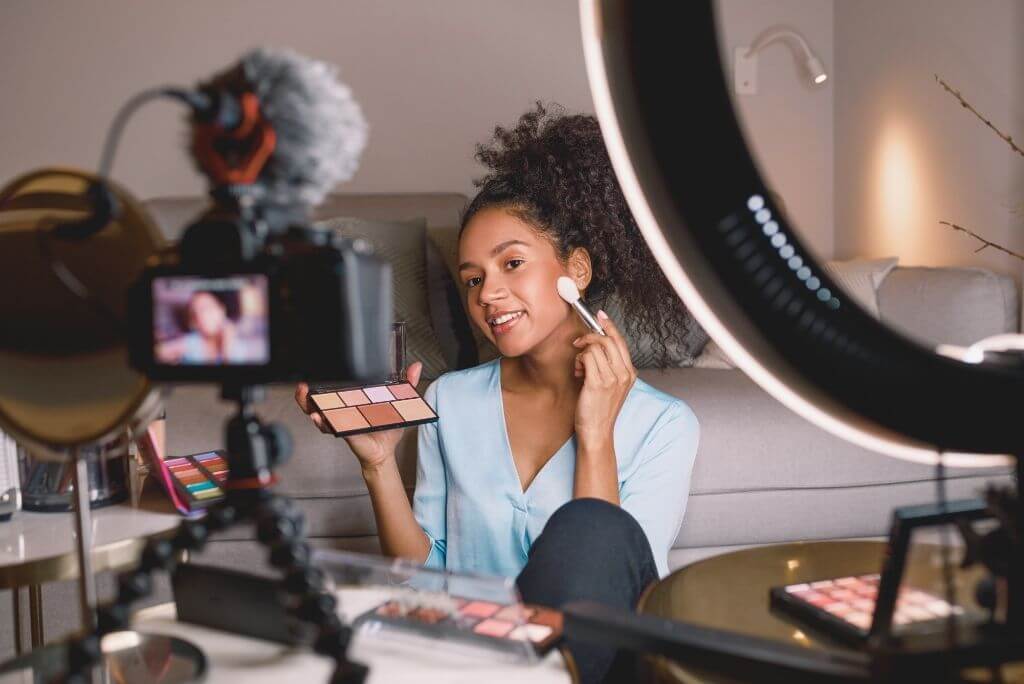Dropshipping Cosmetics: Launch Your Business in 2024

Thinking of entering the world of dropshipping cosmetics? This guide will walk you through everything you need to know to launch a successful cosmetics dropshipping business, from setting up your store to scaling up your profits.
Table of contents
- Understanding how dropshipping cosmetics works
- The pros and cons of dropshipping cosmetics
- Setting up your business
- How to research profitable cosmetics products
- Sourcing reliable suppliers for your business
- How to calculate profits
- Creating eye-catching ads
- Effective marketing tactics for dropshipping cosmetics
- Tracking success and growing your cosmetics store

Understanding how dropshipping cosmetics works
Dropshopping cosmetics allows you to sell beauty products with ease and minimal investment. Here’s how it operates:
- You sell beauty products without holding any inventory yourself.
- When a customer places an order on your store, you forward the order details to a dropship cosmetics supplier.
- The supplier takes care of the packing and shipping directly to your customer.
This low-investment model allows you to launch quickly, with minimal upfront costs and a wide product selection at your fingertips.

What are the pros and cons?
Is dropshipping the right choice for your business? Let’s explore the pros and cons to help you decide.
Pros:
- Low startup costs: You don’t need to buy inventory in bulk.
- Flexibility: You can add or change products easily.
- Scalability: Your suppliers handle logistics, so you can focus on growth.
Cons:
- Lower profit margins: Since suppliers take on the shipping, they charge more per item.
- Limited control over quality: Since you don’t handle products yourself, quality checks are trickier.
- High competition: Dropshipping beauty products is popular, so finding ways to stand out is essential.

Setting up your business
Creating a professional online store is your first step. Platforms like Shopify and WooCommerce make it easy to set up a website optimized for dropshipping makeup.
Ensure your site is visually appealing, and invest time in clear product descriptions, high-quality images, and easy navigation. User experience matters in the beauty industry, where brand perception is essential.
The Right E-Commerce platform for your business
Selecting the right e-commerce platform for your cosmetics dropshipping store is essential, as it affects setup ease and the overall shopping experience. Beginner-friendly platforms like Shopify and WooCommerce offer intuitive dashboards and customizable themes suited for online retail.
Look for key features like integrated payment processing, inventory management tools, and plug-ins that streamline order fulfillment and supplier communication.
It’s also important to consider scalability; as your store grows, you’ll need a platform capable of handling increased traffic and offering advanced customization options to align with your brand’s growth.

Building a brand focused on cosmetics
In the beauty industry, brand identity is a powerful tool for standing out in a competitive market. Focus on creating a brand that aligns with the aesthetics and values of your target audience. From your logo and color scheme to your choice of fonts and imagery, each element should evoke the quality and personality of your products.
If you’re targeting eco-conscious shoppers, for instance, use natural tones and emphasize sustainability in your branding. Consistent messaging across your site and social media channels reinforces your brand, helping to build trust and recognition with your customers.
Adding essential pages to your store
An effective e-commerce store goes beyond just product listings. Essential pages, such as About Us, Shipping and Returns, and FAQ, play a crucial role in providing transparency and building credibility.
The About Us page offers a chance to share your brand’s story, helping customers feel a personal connection. A detailed Shipping and Returns page is important in dropshipping, where longer shipping times can be common; make sure to set realistic expectations and clearly outline your return policy.
Lastly, a well-structured FAQ page answers common questions upfront, reducing customer hesitation and providing a smoother shopping experience.

Designing your store to maximize conversions
A beautiful design is only part of the equation; conversion optimization is essential to turn visitors into buyers. Start by placing clear and visible call-to-action buttons, such as “Add to Cart” or “Shop Now,” throughout your site to guide customers towards purchasing.
Use product images that highlight the beauty and details of each item, helping shoppers envision themselves using it. Testimonials and reviews from previous customers can add credibility and encourage new visitors to purchase.
Additionally, ensure a mobile-friendly design, as a significant portion of shoppers browse on mobile devices. Fast loading times and easy navigation on mobile can help you capture more sales and improve overall user satisfaction.

How to research profitable cosmetics products
Research is key to finding profitable dropshipping cosmetics. Look for trends in the beauty industry, such as eco-friendly or vegan makeup, that attract a specific audience.
Analyze search trends, customer reviews, and competitor products to ensure you’re offering something unique. Identifying a niche will help you stand out and attract a loyal customer base.
- Using Google Trends: Use Google Trends to discover popular and emerging products, analyze interest in keywords like “vegan makeup,” and narrow down by region.
- Keyword Research Tools: Tools like Ubersuggest, Ahrefs, and SEMrush reveal high-demand, low-competition keywords.
- Social Media Analytics: Instagram and Pinterest help spot trends and understand audience preferences.
- Competitor Analysis: Review competitor products and customer feedback on platforms like Amazon.
- Product Research Tools: Dropship Spy and Ecomhunt highlight trending products and suppliers.
- Spotting Seasonal Trends: Stock seasonally relevant items like SPF for summer or hydrating creams for winter.

Sourcing reliable suppliers for your business
Choosing reliable dropship cosmetics suppliers is crucial for customer satisfaction. Here’s how to choose the right suppliers for your business:
- Focus on Quality: Look for suppliers with high-quality, brand-aligned cosmetics like cruelty-free options.
- Evaluate Shipping Speed: Choose suppliers with a strong record of fast, reliable shipping.
- Check Communication: Reliable suppliers offer clear updates and responsive support.
- Research Reviews: Use platforms like Alibaba to find suppliers with consistent quality and communication ratings.
- Order Samples: Assess product quality and shipping by ordering samples.
- Return Policies: Select suppliers with clear, fair return options for customer satisfaction.
- Scalability: Work with suppliers who can handle growing orders and offer bulk discounts to support profit margins.

How to calculate profits
Understanding your costs is essential for profitability. Calculate your profit margin by subtracting the product cost, shipping fees, and other expenses from your selling price.
Aim for a margin that covers your expenses while remaining competitive in the cosmetics dropshipping market. Be mindful of additional fees, such as transaction costs on your eCommerce platform.
To make calculations easier, consider using the profit margin calculator, which allows you to input costs and desired profit margins for quick results. This tool helps you quickly calculate your net profits, factoring in taxes, so you can set realistic and profitable prices without the hassle of complicated calculations.
Profit Margin Calculator
Creating eye-catching ads
In cosmetics, effective advertising is essential, as visual appeal strongly influences buyers. Use high-quality visuals that highlight unique product features and pair them with engaging copy to showcase benefits and appeal to customer desires.
User-generated content (UGC) builds credibility by showcasing real customer photos and testimonials, which resonate more than traditional ads. Encourage social sharing and feature UGC in your ads to highlight authentic results.
Influencer partnerships are impactful in the beauty sector, as influencers have built trust with their followers. Collaborate with those aligned with your audience to showcase products authentically, using tutorials and UGC to help customers envision products in their routines and boost brand authenticity.

Effective marketing tactics for dropshipping cosmetics
With the right marketing strategy, you can attract a steady stream of customers. Consider these popular tactics:
Ads
Targeted ads on Instagram, TikTok, Pinterest, and Google Ads effectively reach beauty shoppers seeking inspiration. Instagram and TikTok work well for engaging, short-form videos, while Pinterest targets users searching for beauty ideas.
Google Ads complements these by capturing search-driven traffic with keywords like “vegan lipstick.” Testing formats like carousel or video ads on social media and search ads on Google helps identify what drives the best results.
Content marketing
Creating beauty guides, skincare routines, and makeup tutorials attracts organic traffic and positions your brand as an authority. This content improves SEO and helps your site rank higher.
Focus on answering common beauty questions, providing tutorials, and showcasing product benefits through blog posts, YouTube videos, and social media for steady, quality traffic.
Influencer marketing
Partnering with beauty influencers boosts brand visibility and credibility through trusted recommendations. Collaborate with influencers whose followers match your target audience, such as clean beauty fans or makeup artists.
Authentic product demos and reviews drive engagement and conversions, so explore both micro- and macro-influencers to find the best fit for your brand.

Tracking success and growing your cosmetics store
Regularly analyze your store’s performance to understand which products sell best, where customers come from, and which ads convert. Use analytics tools to track metrics like conversion rate, customer acquisition cost, and profit margins.
When your store starts generating consistent sales, consider expanding your product range or investing more in high-performing ads to scale.



